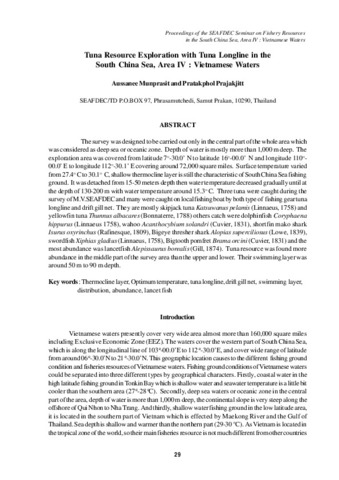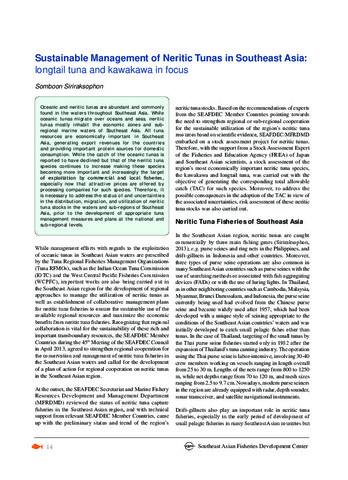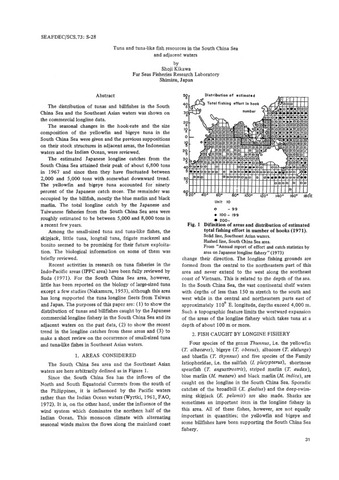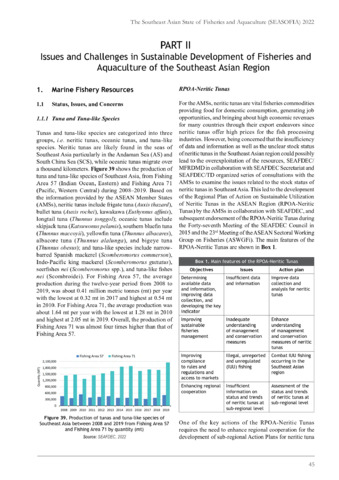Tuna resource exploration with tuna longline in the South China Sea, Area IV: Vietnamese waters
Share
Abstract
The survey was designed to be carried out only in the central part of the whole area which was considered as deep sea or oceanic zone. Depth of water is mostly more than 1,000 m deep. The exploration area was covered from latitude 7°-30.0’ N to latitude 16°-00.0’ N and longitude 110°-00.0’ E to longitude 112°-30.1’ E covering around 72,000 square miles. Surface temperature varied from 27.4° C to 30.1° C, shallow thermocline layer is still the characteristic of South China Sea fishing ground. It was detached from 15-50 meters depth then water temperature decreased gradually until at the depth of 130-200 m with water temperature around 15.3° C. Three tuna were caught during the survey of M.V. SEAFDEC and many were caught on local fishing boat by both type of fishing gear tuna longline and drift gill net. They are mostly skipjack tuna Katsuwanus pelamis (Linnaeus, 1758) and yellowfin tuna Thunnus albacares (Bonnaterre, 1788) others catch were dolphinfish Coryphaena hippurus (Linnaeus 1758), wahoo Acanthocybium solandri (Cuvier, 1831), shortfin mako shark Isurus oxyrinchus (Rafinesque, 1809), Bigeye thresher shark Alopias superciliosus (Lowe, 1839), swordfish Xiphias gladius (Linnaeus, 1758), Bigtooth pomfret Brama orcini (Cuvier, 1831) and the most abundance was lancetfish Alepissaurus borealis (Gill, 1874). Tuna resource was found more abundance in the middle part of the survey area than the upper and lower. Their swimming layer was around 50 m to 90 m depth.
Suggested Citation
Munprasit, A., & Prajakjitt, P. (2001). Tuna resource exploration with tuna longline in the South China Sea, Area IV: Vietnamese waters. In Proceedings of the Fourth Technical Seminar on Marine Fishery Resources Survey in the South China Sea, Area IV: Vietnamese Waters, 18-20 September 2000 (pp. 29-40). Bangkok, Thailand: Secretariat, Southeast Asian Fisheries Development Center.
Subject
vertical distribution  ; catch composition
; catch composition  ; pelagic fisheries
; pelagic fisheries  ; fishery surveys
; fishery surveys  ; stock assessment
; stock assessment  ; longlining
; longlining  ; fishing grounds
; fishing grounds  ; thermocline
; thermocline  ; tuna fisheries
; tuna fisheries  ; fishery resources
; fishery resources  ; Alopias superciliosus; Coryphaena hippurus; Xiphias gladius; Thunnus albacares; Acanthocybium solandri; Isurus oxyrinchus; Euthynnus pelamis; Brama orcini; Alepisaurus ferox; Viet Nam; South China Sea
; Alopias superciliosus; Coryphaena hippurus; Xiphias gladius; Thunnus albacares; Acanthocybium solandri; Isurus oxyrinchus; Euthynnus pelamis; Brama orcini; Alepisaurus ferox; Viet Nam; South China Sea
 ; catch composition
; catch composition  ; pelagic fisheries
; pelagic fisheries  ; fishery surveys
; fishery surveys  ; stock assessment
; stock assessment  ; longlining
; longlining  ; fishing grounds
; fishing grounds  ; thermocline
; thermocline  ; tuna fisheries
; tuna fisheries  ; fishery resources
; fishery resources  ; Alopias superciliosus; Coryphaena hippurus; Xiphias gladius; Thunnus albacares; Acanthocybium solandri; Isurus oxyrinchus; Euthynnus pelamis; Brama orcini; Alepisaurus ferox; Viet Nam; South China Sea
; Alopias superciliosus; Coryphaena hippurus; Xiphias gladius; Thunnus albacares; Acanthocybium solandri; Isurus oxyrinchus; Euthynnus pelamis; Brama orcini; Alepisaurus ferox; Viet Nam; South China Sea
Related items
Showing items related by title, author, creator and subject.
-
Sustainable management of neritic tunas in Southeast Asia: Longtail tuna and kawakawa in focus
Siriraksophon, Somboon (Secretariat, Southeast Asian Fisheries Development Center, 2017)Oceanic and neritic tunas are abundant and commonly found in the waters throughout Southeast Asia. While oceanic tunas migrate over oceans and seas, neritic tunas mostly inhabit the economic zones and subregional marine ... -
Tuna and tuna-like fish resources in the South China Sea and adjacent waters
Kikawa, Shoji (Japan International Cooperation Agency, 1977)The distribution of tunas and billfishes in the South China Sea and the Southeast Asian waters was shown on the commercial longline data. The seasonal changes in the hook-rate and the size composition of the yellowfin and ... -
Issues and challenges in sustainable development of fisheries and aquaculture of the Southeast Asian Region: Marine fishery resources: Tuna and tuna-like species
Saleh, Mohammad Faisal Md.; Arshaad, Wahidah Mohd; Billy, Annie Nunis; Ali, Mazalina; Azmi, Mohamad Syahidan (Secretariat, Southeast Asian Fisheries Development Center, 2022)




